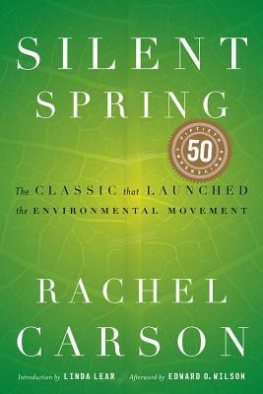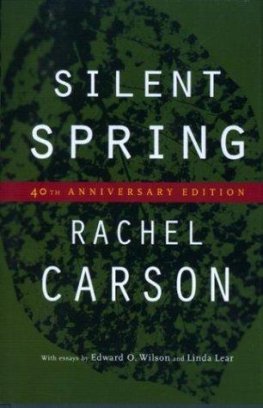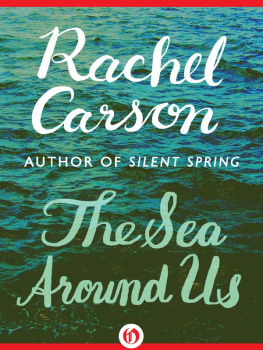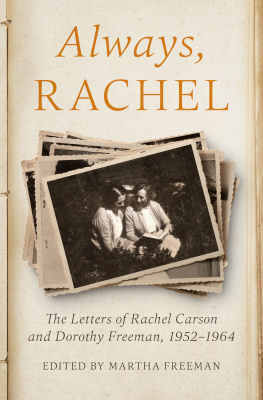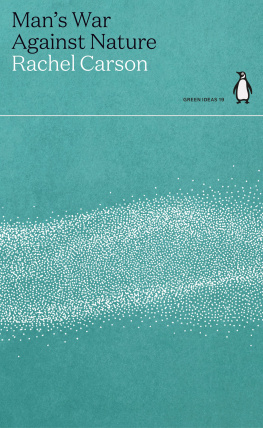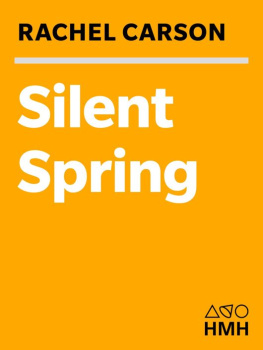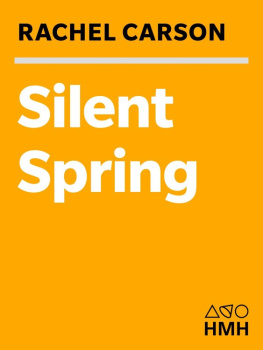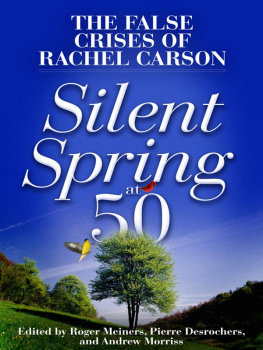To Albert Schweitzer
who said
"Man has lost the capacity to foresee and to forestall.
He will end by destroying the earth."
First Mariner Books edition 2002
Copyright 1962 by Rachel L. Carson
Copyright renewed 1990 by Roger Christie
Introduction copyright 2002 by Linda Lear
Afterword copyright 2002 by Edward O. Wilson
All rights reserved
For information about permission to reproduce selections from this book, write to Permissions, Houghton Mifflin Harcourt Publishing Company, 215 Park Avenue South, New York, New York, 10003.
www.hmhbooks.com
Library of Congress Cataloging-in-Publication Data is available.
ISBN 0-618-25305-x
ISBN 0-618-24906-0 (pbk.)
Drawings by Lois and Louis Darling
Portions of this book were first published as a series of
articles in The New Yorker.
eISBN 978-0-547-52762-8
v2.0912
The sedge is wither'd from the lake,
And no birds sing.
K EATS
***
I am pessimistic about the human race because it is too ingenious for its own good. Our approach to nature is to beat it into submission. We would stand a better chance of survival if we accommodated ourselves to this planet and viewed it appreciatively instead of skeptically and dictatorially.
E. B. W HITE
Author's Note
I HAVE NOT WISHED to burden the text with footnotes but I realize that many of my readers will wish to pursue some of the subjects discussed. I have therefore included a list of my principal sources of information, arranged by chapter and page, in an appendix which will be found at the back of the book.
R.C.
Acknowledgments
I N A LETTER written in January 1958, Olga Owens Huckins told me of her own bitter experience of a small world made lifeless, and so brought my attention sharply back to a problem with which I had long been concerned. I then realized I must write this book.
During the years since then I have received help and encouragement from so many people that it is not possible to name them all here. Those who have freely shared with me the fruits of many years' experience and study represent a wide variety of government agencies in this and other countries, many universities and research institutions, and many professions. To all of them I express my deepest thanks for time and thought so generously given.
In addition my special gratitude goes to those who took time to read portions of the manuscript and to offer comment and criticism based on their own expert knowledge. Although the final responsibility for the accuracy and validity of the text is mine, I could not have completed the book without the generous help of these specialists: L. G. Bartholomew, M.D., of the Mayo Clinic, John J. Biesele of the University of Texas, A.W.A. Brown of the University of Western Ontario, Morton S. Biskind, M.D., of Westport, Connecticut, C. J. Briejr of the Plant Protection Service in Holland, Clarence Cottam of the Rob and Bessie Welder Wildlife Foundation, George Crile, Jr., M.D., of the Cleveland Clinic, Frank Egler of Norfolk, Connecticut, Malcolm M. Hargraves, M.D., of the Mayo Clinic, W. C. Hueper, M.D., of the National Cancer Institute, C. J. Kerswill of the Fisheries Research Board of Canada, Olaus Murie of the Wilderness Society, A. D. Pickett of the Canada Department of Agriculture, Thomas G. Scott of the Illinois Natural History Survey, Charence Tarzwell of the Taft Sanitary Engineering Center, and George J. Wallace of Michigan State University.
Every writer of a book based on many diverse facts owes much to the skill and helpfulness of librarians. I owe such a debt to many, but especially to Ida K.Johnston of the Department of the Interior Library and to Thelma Robinson of the Library of the National Institutes of Health.
As my editor, Paul Brooks has given steadfast encouragement over the years and has cheerfully accommodated his plans to postponements and delays. For this, and for his skilled editorial judgment, I am everlastingly grateful.
I have had capable and devoted assistance in the enormous task of library research from Dorothy Algire, Jeanne Davis, and Bette Haney Duff. And I could not possibly have completed the task, under circumstances sometimes difficult, except for the faithful help of my housekeeper, Ida Sprow.
Finally, I must acknowledge our vast indebtedness to a host of people, many of them unknown to me personally, who have nevertheless made the writing of this book seem worthwhile. These are the people who first spoke out against the reckless and irresponsible poisoning of the world that man shares with all other creatures, and who are even now fighting the thousands of small battles that in the end will bring victory for sanity and common sense in our accommodation to the world that surrounds us.
R ACHEL C ARSON
Introduction
by Linda Lear
H EADLINES IN THE New York Times in July 1962 captured the national sentiment: "Silent Spring is now noisy summer." In the few months between the New Yorker's serialization of Silent Spring in June and its publication in book form that September, Rachel Carson's alarm touched off a national debate on the use of chemical pesticides, the responsibility of science, and the limits of technological progress. When Carson died barely eighteen months later in the spring of 1964, at the age of fifty-six, she had set in motion a course of events that would result in a ban on the domestic production of DDT and the creation of a grass-roots movement demanding protection of the environment through state and federal regulation. Carson's writing initiated a transformation in the relationship between humans and the natural world and stirred an awakening of public environmental consciousness.
It is hard to remember the cultural climate that greeted Silent Spring and to understand the fury that was launched against its quietly determined author. Carson's thesis that we were subjecting ourselves to slow poisoning by the misuse of chemical pesticides that polluted the environment may seem like common currency now, but in 1962 Silent Spring contained the kernel of social revolution. Carson wrote at a time of new affluence and intense social conformity. The cold war, with its climate of suspicion and intolerance, was at its zenith. The chemical industry, one of the chief beneficiaries of postwar technology, was also one of the chief authors of the nation's prosperity. DDT enabled the conquest of insect pests in agriculture and of ancient insect-borne disease just as surely as the atomic bomb destroyed America's military enemies and dramatically altered the balance of power between humans and nature. The public endowed chemists, at work in their starched white coats in remote laboratories, with almost divine wisdom. The results of their labors were gilded with the presumption of beneficence. In postwar America, science was god, and science was male.
Carson was an outsider who had never been part of the scientific establishment, first because she was a woman but also because her chosen field, biology, was held in low esteem in the nuclear age. Her career path was nontraditional; she had no academic affiliation, no institutional voice. She deliberately wrote for the public rather than for a narrow scientific audience. For anyone else, such independence would have been an enormous detriment. But by the time Silent Spring was published, Carson's outsider status had become a distinct advantage. As the science establishment would discover, it was impossible to dismiss her.
Rachel Carson first discovered nature in the company of her mother, a devotee of the nature study movement. She wandered the banks of the Allegheny River in the pristine village of Springdale, Pennsylvania, just north of Pittsburgh, observing the wildlife and plants around her and particularly curious about the habits of birds.
Next page
